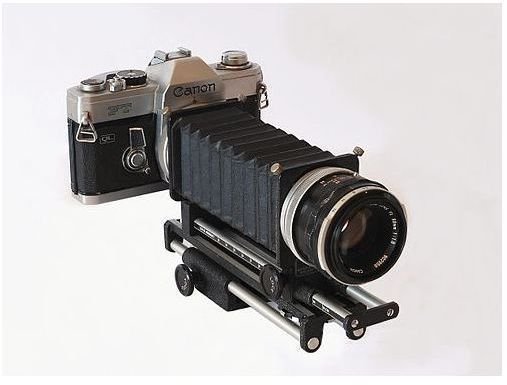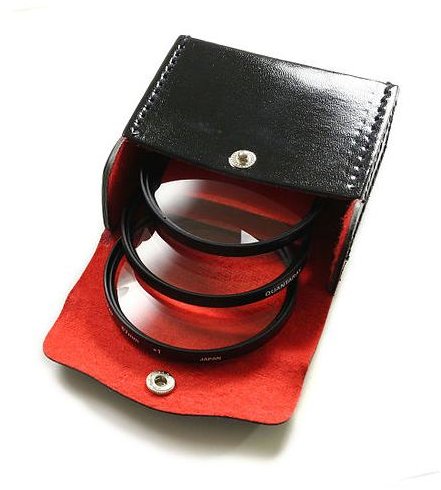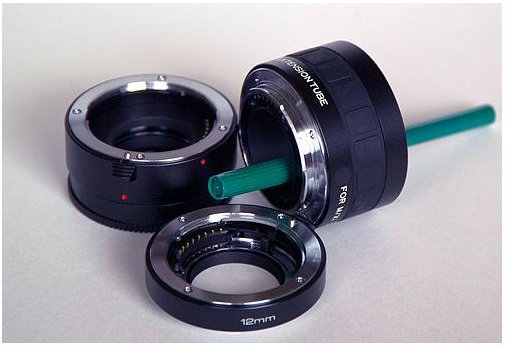Equipment for Macro Photography - Macro Lenses, Extension Tubes, and Bellows Attachments
Equipment Options for Close-Up Photography
Attachments like close-up filters, macro lenses, extension tubes and bellows are all ways to expand the close-up capabilities of your camera, whether you’re shooting film or digital. Each piece of equipment has its good points and its not-so-good points, so before you buy, find out the pros and cons of the accessories you’re interested in.
One thing to keep in mind while considering close-up photography is that the higher the magnification, the shallower the depth of field, so you’ll need to use the smallest aperture you can. Any camera movements will be exaggerated, too, so a tripod is a good idea (and a necessity with some attachments). Finally, consider lighting. At small apertures, you’ll need more light, so think about flashes (will you need a ring flash, for example) and reflectors.
Macro Lenses
What they are: Macro lenses are lenses designed specifically to achieve high magnification by allowing the image to be focused with the front of the lens extremely close to the subject. They are commonly available in a variety of fixed focal lengths, but they can focus to infinity, so get one for the largest magnification you think you’ll need.
Pros: The optical quality is very good, and you get what you pay for, so (generally) the higher the price the better the quality. Of all the close-up options (except close-up filters), macro lenses will give you the best range of apertures. They are relatively small, being about the same size as a normal lens (depending on what focal length you choose), and they can focus anywhere from a few inches to infinity (the range varies with the lens). Because they mount to the body like any other lens, they can make use of any automatic functions.
Cons: Macro lenses tend to be quite expensive, and their widest aperture is relatively small compared to a normal lens.
Extension Tubes
What they are: Extension tubes are cylinders that are attached between the body of the camera and the lens, essentially extending the focal length of the lens and allowing extremely close focusing. They generally come in a set of three with fixed magnifications and can be used alone or in combination. It is also possible to get variable-length extension tubes that don’t have a fixed focal length, but they are harder to find. Extension tubes can be used with normal lenses or macro lenses.
Pros: Extension tubes are less expensive than a macro lens, but will probably be harder to find–especially ones that will work with the auto functions of a digital camera. They’re light and convenient, and have good optical quality.
Cons: The longer the length of the tubes, the more time you have to add to your exposures–you can’t simply use the exposure on your light meter, but will have to add time (this is usually engraved on the tube itself). If you carry the whole set around, they can get bulky. Unlike macro lenses, extension tubes can focus only within a narrow range of distance, and they will generally require a tripod. Unless they’re specifically designed for the particular camera they’re used on, extension tubes will interrupt any automatic functions. Finally, you have to be careful of any extraneous light as extension tubes can be prone to hotspots.
Bellows Attachments

What they are: A bellows attachment looks just like the bellows on a large-format camera, but smaller, and fits between the camera body and the lens. A bellows attachment can be used with a regular lens, a macro lens, or a special bellows lens.
Pros: Many of the advantages are the same as for extension tubes, but bellows attachments are much more adjustable, and much less prone to hotspots. A bellows allows magnification up to 5 times life size or even greater (depending on the specific attachment used).
Cons: A bellows requires a special mount so they are usually more suited to studio than field use. Like extension tubes, they require longer exposures (calculated from the length of the bellows when set up for a shot), and they can only focus close up within a narrow range of distance (though because they’re more adjustable, they have greater range than extension tubes). Using a bellows is pretty much impossible without a tripod, and unless they are specifically designed for the camera they will interrupt automatic functions between the camera and the lens.
Close-Up Filters

What they are: Also called close-up lenses (not to be confused with macro lenses) and supplementary lenses, close-up filters look like colorless filters. They screw directly onto the threads on a standard lens and usually come in sets of three. They can be used individually or in combination. Close-up filters work both by adding their own magnification to that of the lens, and by changing the focusing distance of the lens to allow a closer focus.
Pros: Close-up filters are small, and inexpensive, and can be combined for different magnifications. They don’t require huge amounts of light or adjustment of exposure. In addition to magnifying close-up shots, they can also be used to exaggerate the compression of perspective on long lenses.
Cons: The more layers of glass you add, the more optical distortion and reflections are likely, and the more possibility of dust and fingerprints. Unlike macro lenses, close-up filters can only focus within a specific narrow range of distances. There is some loss of definition compared to the above equipment, especially with cheaper lenses, though use of smallest possible aperture can bring that to an acceptable level.
Reversal Rings
What they are: A reversal ring is an attachment that makes it possible to attach any lens to the camera backwards, which is sometimes called the reverse-lens technique. This allows for closer focusing, though actual performance will vary depending on the lens.
Pros: You don’t have to buy another lens, and the optical quality will be as good as the lens itself.
Cons: Attaching the lens backwards leaves the back of the lens unprotected while in use, and you can’t adjust anything automatically through the camera (including diaphragm). Reversal rings are not common pieces of equipment, so they can be difficult to find.
Zoom-as-Macro
What it is: It is possible to take close-up photographs by getting farther away and using a zoom lens (aka telephoto lens) to magnify the subject. This is particularly useful if you already have a zoom lens. Often, standing back and using the zoom on a so-called “macro zoom” lens (an adjustable-length lens that ranges from macro lengths to zoom lengths) will give better results than trying the same shot with the macro on the same lens.
Pros: Using zoom as macro doesn’t require the purchase of a separate lens if you already have a zoom lens. If you’re shooting digital, you may find this gives better results than expected (zoom-as-macro tends to work somewhat better with digital than with film).
Cons: Long lenses needs more light and the range of apertures on a zoom lens tends to be small. Longer exposures mean more possibility of camera shake, and longer lenses exaggerate camera movements. Generally, zoom-as-macro will have a lower optical quality than a dedicated lens, but it will depend on the lens and what your specific needs are.
Digital Close-Up
What it is: Most digital cameras, from inexpensive point-and-shoot to high-quality DSLRs, have a close-up or macro setting. The magnification will depend on the camera in question, but you can’t usually get as close-up as you would with special equipment.
Pros: The setting is built into the camera, so it doesn’t require any extra expense or equipment.
Cons: The quality is limited by the capabilities of the individual camera, and you often can’t get as close as with other options. Most macro or close-up settings work automatically, meaning you won’t have any control over aperture or exposure length.
Conclusions
What you decide to buy will depend on your own budget and the needs of your work. If you find the built-in functions of your camera aren’t good enough, try zoom-as-macro if you already have a suitable lens or plan to buy a zoom lens anyway. Or try adding some close-up filters–see how much you use them, and if the quality is good enough. Then consider moving up to bellows, extension tubes or a macro lens (or a combination), depending on the specific needs of your work, or where you’ll be shooting.
References
Calder, Julian and John Garrett. The 35mm Photographer’s Handbook. Pan Books, 1982.
Dorrell, Peter G. Photography in Archaeology and Conservation. Second edition. Cambridge UP, 1994.
Eastman Kodak Company. The Joy of Photography. Addison-Wesley Publishing Company, 1979.
Horenstein, Henry. Black & White Photography: A Basic Manual. Third edition, revised. Little, Brown and Company, 2005.
Jackson, Bernard S. Photographing Wildflowers (And Other Plantlife) With Natural Light. Memorial University of Newfoundland, 1973.
Pentax Corporation. Photography: The Infinite Image. Pentax Corporation, no date.
Upton, Barbara London, with John Upton. Photography. Fourth edition. Scott, Foresman and Company, 1989.
Extension tube image: Extension Tubes by Fg2 (Own work) [Public domain], via Wikimedia Commons.
Bellows attachment image: A bellows for macrophotography mounted in a Canon FT QL by By Alvesgaspar (Own work) [CC-BY-SA-3.0 or GFDL], via Wikimedia Commons.
Close-up filters image: Set of three close-up lenses by Andrew Magill (Flickr) [CC-BY-2.0], via Wikimedia Commons.
